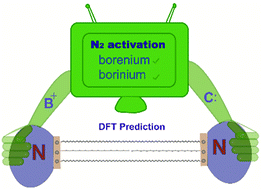Predicting dinitrogen activation by borenium and borinium cations†
Abstract
The activation of thermodynamically stable and kinetically inert dinitrogen (N2) has been a great challenge due to the significant strength of the triple bond. Recently, in an experimental study on N2 activation by boron species, a highly reactive two-coordinated borylene broke through the limitations of traditional strategies of N2 activation by metal species. Still, studies on metal-free N2 activation remain underdeveloped. Here, we systematically investigate a frustrated Lewis pair (FLP) combining carbene and borenium (or borinium) cations to screen potential candidates for N2 activation via density functional theory calculations. As a result, we found that two FLPs (closed form FLP, borenium and open form FLP, borinium) are able to activate N2 in a thermodynamically and kinetically favorable manner, with a low energy barrier of 9.6 and 7.3 kcal mol−1, respectively. Furthermore, aromaticity was found to play an important role in the stabilization of the products, supported by nucleus-independent chemical shift (NICS), anisotropy of the current-induced density (ACID) and electron density of delocalized bonds (EDDB) analysis. Our findings provide an alternative approach for metal-free N2 activation, highlighting the importance of FLP chemistry and aromaticity in N2 activation.



 Please wait while we load your content...
Please wait while we load your content...